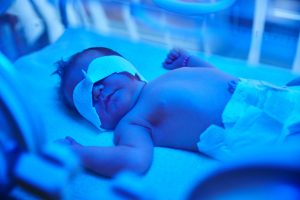Jaundice
What is Newborn Jaundice?
Jaundice is distinguished by a yellow colouring of the infant’s skin and eyes which begins on the 3rd or 4th day after birth. Around 60% of full term babies will develop jaundice, and some babies will require treatment for the condition.
What Causes Jaundice?
Red blood cells are being continually produced and broken down in all individuals, including babies before and after birth. After birth, the newborn’s liver has to suddenly take on the work of getting rid of the red blood cells as they have a limited lifespan. It can take the newborn’s liver several days to fully manage the excess bilirubin (a substance produced during the breakdown of red blood cells). During this period, the level of bilirubin in the baby’s body rises, causing the yellowish discolouration of the skin, also known as jaundice.
What can I Expect? Is There Any Danger?
If your infant or child appears to be jaundiced, your paediatrician can conduct a blood test to work out the level of bilirubin in the body. Depending on the test results and general health of the baby, your doctor will decide if further treatment is necessary.
Most cases of jaundice usually improve or disappear within 1 to 2 weeks without further complications. However, if the level of bilirubin in the baby’s blood rises to a very high level, it can cause kernicterus, in which parts of the brain that impair hearing, vision and control of movement are damaged. This can lead to severe lifelong implications.
What should I Do for My Baby with Jaundice?

If your baby’s bilirubin level is getting higher above the normal range, phototherapy treatment may be carried out, either in a hospital or at home. He or she will be placed under a fluorescent light. The light energy will help convert the bilirubin under the skin into a different and less harmful chemical which the body can easily expel. The baby’s eyes will be covered during treatment to protect them from the intense light. In the rare case that bilirubin levels get too high, the baby may need an exchange transfusion.
Avoid treating jaundice by placing your baby outdoors in the sun or near a window as special lighting and a controlled surrounding are essential to treating the condition safely. Parents should also ensure their baby feeds adequately as this helps rid the body of excess bilirubin.
Read more on Managing Your Baby’s Needs (0-6 months)
When should I Seek Treatment?
Parents can closely monitor the baby’s skin twice a day to ensure the skin and eye colour is returning to normal. Consult a doctor if you notice the yellowish tinge is becoming more pronounced, if your baby seems unwell (e.g. not feeding well or has a fever), or if the jaundice is prolonged for more than 2 weeks.

